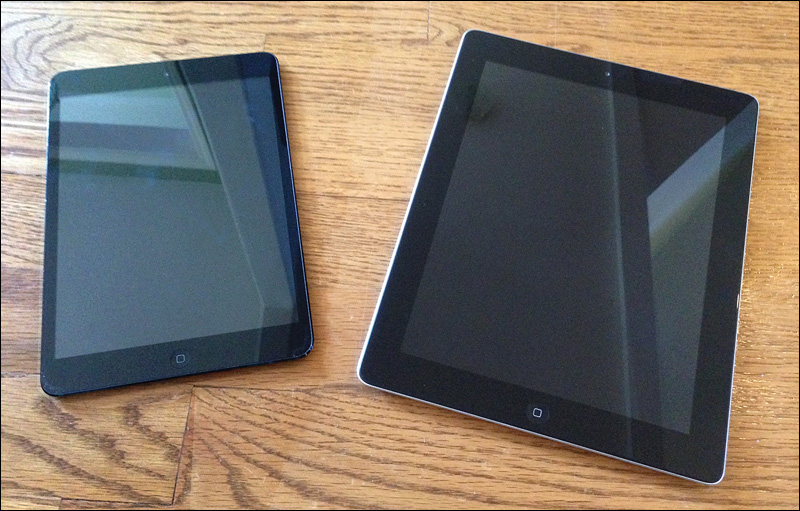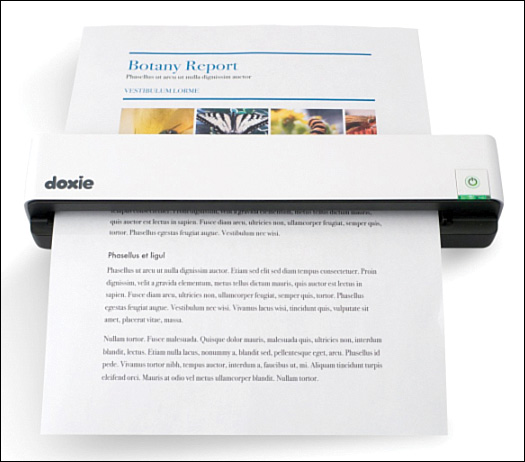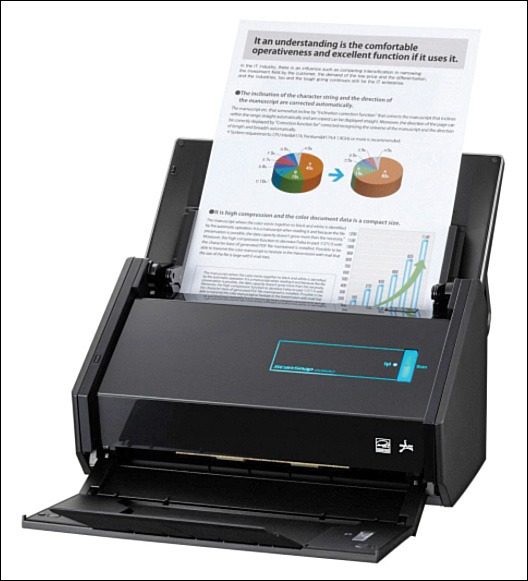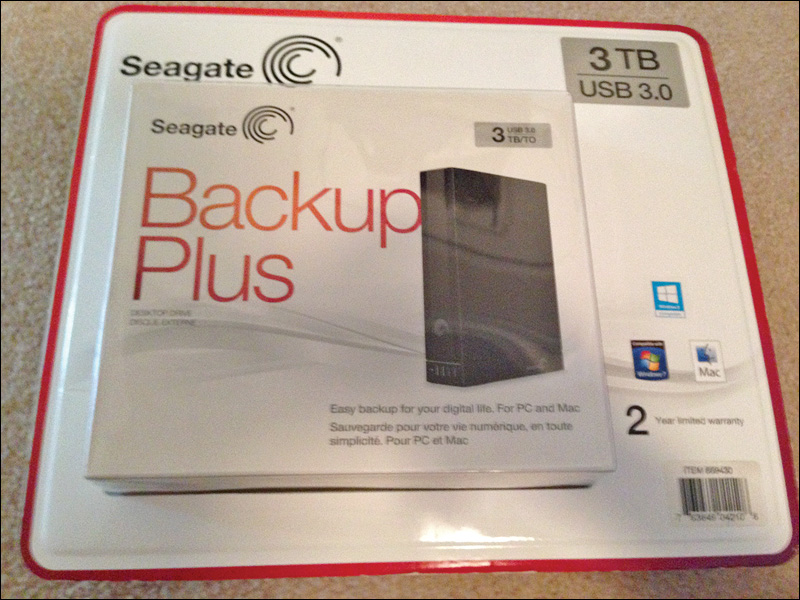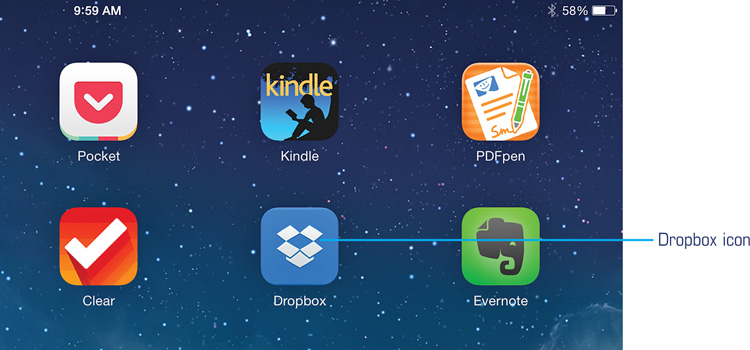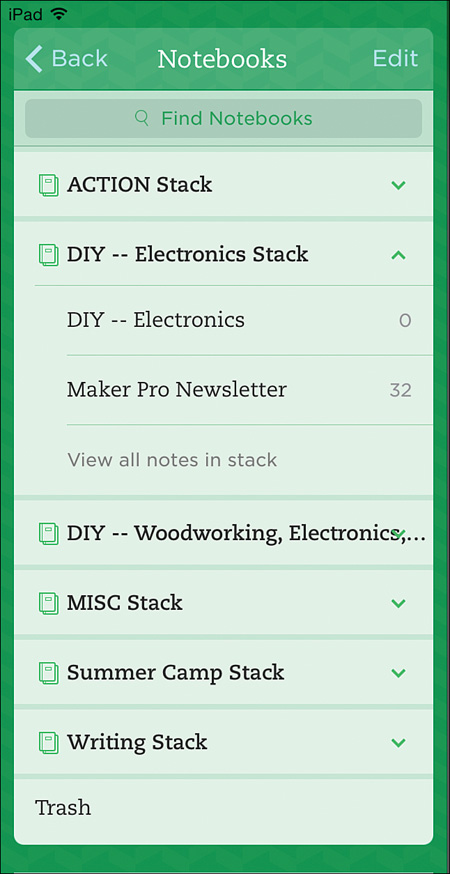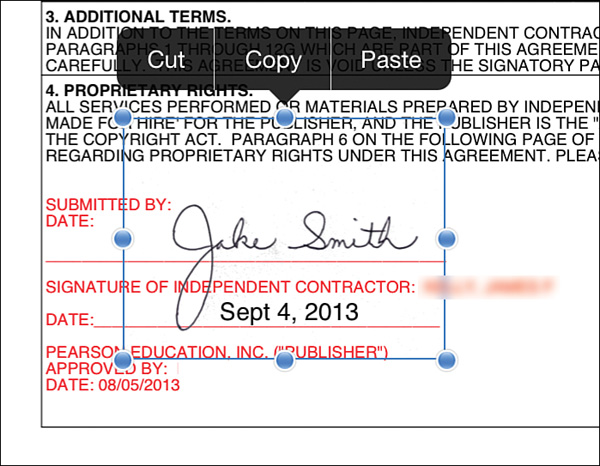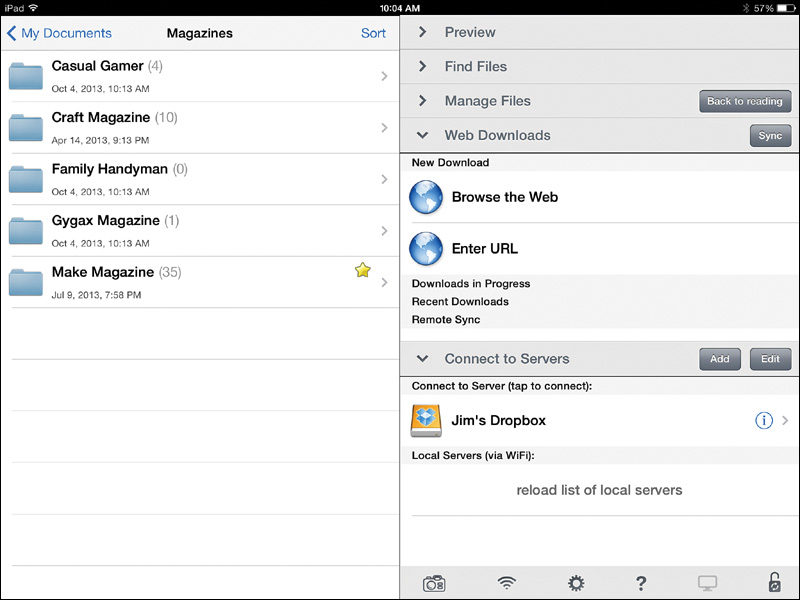1. The Ultimate iPad
In This Chapter
![]() Push your iPad to its limits
Push your iPad to its limits
![]() Hardware and software (apps) you will need
Hardware and software (apps) you will need
![]() An example of an Ultimate iPad
An example of an Ultimate iPad
Ask anyone who knows me, and they can confirm that I really do tend to carry my iPad with me no matter where I go. I’m not a gadget freak, honestly—and I’m totally over the iPad. But I use my iPad for everything. Everything. Over the last four years (starting with the first iPad in 2010), I’ve managed to figure out a lot of tricks and shortcuts and other ways to make the iPad really work for me. For me, it’s not about the gadget; rather, it’s about all what the gadget brings to my home and work life—reduced stress, saved time, improved efficiency, and much more. Suffice it to say, the iPad has become an indispensable tool for me—I spend more time using it than I do my Windows computer or my Mac laptop.
For the past few years, I have been asked one type of question over and over by friends and colleagues, and it pertains to my reliance on my Apple iPad: “How do you do ______?”
Sometimes the question takes a different format: “Can you show me how to _____?” or “I don’t know how to make my tablet do ______.” But ultimately what they’re asking is for me to show them some particular task that they’ve seen me demonstrate or explain why I do something in a particular manner. Here are some examples:
![]() How did you get all your DVD movies onto your iPad?
How did you get all your DVD movies onto your iPad?
![]() That book isn’t available as an ebook—how did you get it on your iPad?
That book isn’t available as an ebook—how did you get it on your iPad?
![]() Do you really keep your kids’ mazes and activity books on your iPad?
Do you really keep your kids’ mazes and activity books on your iPad?
![]() Why do you pay for a Dropbox account—isn’t it free to use?
Why do you pay for a Dropbox account—isn’t it free to use?
![]() Is your office really “paper free”? Really? Where does all the paper go?
Is your office really “paper free”? Really? Where does all the paper go?
![]() What is that Evernote app you have installed on every device you own?
What is that Evernote app you have installed on every device you own?
![]() Would you show me that cool productivity app you use again?
Would you show me that cool productivity app you use again?
![]() You safely monitor your investments from your iPad?
You safely monitor your investments from your iPad?
![]() Can you really monitor your home and turn on and off appliances with your iPad?
Can you really monitor your home and turn on and off appliances with your iPad?
The questions don’t stop—and neither does the training. I’m usually more than happy to demonstrate to someone (time permitting) how I use my tablet to make my life easier. And when I say “my life,” I’m talking about my personal (home) life and my work life. Friends and family often catch a glimpse of me doing something productive with my iPad and wonder if it might work for them. And usually the answer is, yes!
I’m not going to tell you that your iPad (or other tablet) is the ultimate solution to all your problems. But I am going to tell you that with a few minor changes to how you do your day-to-day tasks, you can and will find that a tablet often makes your life easier. For the remainder of this book, I’m going to explain some of the tools and processes I use to make my “digital life” run smoothly.
These tools and processes aren’t any big secrets; I make no claim to creating them. And unlike many authors who require you to read the entire book to get the complete list of apps and tools, I’m going to tell you everything I use in this first chapter—complete with pricing. I don’t want to waste your time, and I’m sure you don’t want your time wasted. But if you find yourself interested and wanting more details about how to use a particular piece of hardware or software, you can jump to the chapter in question. Feel free to skip any of my suggestions that don’t apply to your needs.
The iPad isn’t an inexpensive device, and when I first got one I really struggled to find a way to justify the expense. Now, four years after my first iPad (I’ve upgraded since then), I have finally reached a point where the cost of my iPad is a drop in the bucket compared to the time savings and conveniences it offers to me. My hope for this book is that you will walk away with a more solid understanding of just how far you can push your iPad as well as make your iPad earn back its price.
What Will I Need?
In this section, I want to briefly but accurately provide you with a list of most all the software and hardware I cover in this book. You will absolutely not need to purchase everything on this list, and in many instances some of the items (mainly software apps) will be free. I will do my best to provide you with a range of prices for hardware, apps, and services where these exist, along with a discussion of the price differences.
What I would recommend to you is this—examine the list, find those items that won’t break your budget, and then read the respective chapters to understand what you’re getting for the money and what the list item offers to you as an iPad user. I didn’t start with all these items but instead gathered them over the last few years as I needed or discovered them. Feel free to do the same; this isn’t a race. Purchase what you find useful, and ignore the rest.
Some items covered in this book didn’t make it into this initial list—these are mainly services and specialty hardware that I only want to introduce to you but aren’t considered critical to turning your iPad into what I call an Ultimate Productivity Machine.
And what might you need to purchase? Glad you asked.
iPad: $329–$929 (New)
The most obvious item you will need is an iPad. Figure 1.1 shows the original 10" version and the iPad Mini (7"). Whether your iPad is a Wi-Fi-only version or you’re paying a data carrier such as Verizon or AT&T for always-available Internet, this book won’t be all that useful to you without one.
Does it need to be running the latest operating system (iOS 7 at the time I’m writing this chapter)? Absolutely not. However, in some instances a few apps might not work with the oldest versions (iOS 4, for example). With the exception of a small number of apps, most of this book will be useful to someone with the original iPad (1).
The original iPad didn’t come with a camera, but since the iPad 2, all iPad tablets (including the Mini) come with front- and rear-facing cameras. These can be important tools, as you’ll soon discover, but don’t sweat it if you own the original iPad.
Last but not least, one other concern for iPad owners relates to memory. iPads provide between 16GB and 128GB of storage, and every iPad owner will tell you that free space seems to go quickly. Don’t worry about storage space right now—you’ll learn about some options that will remove the fear of running out of space.
Note
Although I focus on the iPad in this book, I’m not saying the advice, apps, and hardware found in this book can’t be used with another brand of tablet. In some instances, the apps I reference are only available for the iPad, but that doesn’t mean the app developer hasn’t made a version for other tablet operating systems. And many of the tricks and tasks you’ll see in this book can easily be duplicated for any tablet, not just the iPad. You may have to do some digging to find compatible apps or services, but rest assured if an app is popular with iPad users, some enterprising individual or company is offering a similar app for other tablets.
Personal Scanner: $120–$500
A personal scanner is simply a piece of hardware that converts a photo or document to a digital file that can be viewed on your iPad (or computer). Think of a scanner as a photocopier that scans the item you give it, but instead of spitting out a duplicate copy on paper, it lets you open and view it (and in most instances modify it) on your iPad or computer screen.
Although a personal scanner is going to make your life so much easier, I should tell you right now that it’s also one of those items that you can postpone purchasing indefinitely or until you do some research and examine your budget. I’m telling you this first so you’ll understand just how noncritical it is to own a scanner—there are plenty of workarounds, such as using your iPad to scan (except the original iPad), as you’ll soon see, and there are also scanning services for those who find they just don’t have a lot of stuff to scan. (More on this in Chapter 5, “Cut the Clutter: Scan Everything.”)
Personal scanners come in a wide range of sizes, shapes, and prices. The older flatbed-type scanners are really almost obsolete compared to the speed-demon scanners available today. You can find scanners that only scan in one black-and-white page (single sided) at a time as well as scanners that use a feeder to handle 100+ double-sided full-color pages at a time. What it comes down to is your budget.
Take a look at Figure 1.2, and you’ll see an example of a simple scanner that can scan both sides of a page, and in color. It’s called the Doxie Go, and for over a year this was the scanner that sat on my desk.
The Doxie Go is convenient for a number of reasons—it’s small and lightweight, making it easy to carry. It has a rechargeable battery, so you don’t have to have it plugged into the wall. It also has a large internal memory, so you can scan in items without connecting it to your computer—simply download all the scans at your convenience! You can buy the Doxie Go for approximately $190, and it is without a doubt one of the most reliable little personal scanners you can find. (A lower-priced version called the Doxie One must be plugged into wall power, but it can be found for around $130 and offers the same quality in terms of scanning.)
Although I really enjoyed my Doxie Go, I upgraded a bit later to two different scanners from Fujitsu. The first was the ScanSnap 1300i, shown in Figure 1.3.
The 1300i is slightly larger in size than the Doxie Go, but rather than feed in a single sheet at a time, the 1300i holds up to 10 sheets of paper in a feeder in the back and the paper is pulled in one sheet at a time. As with the Doxie Go, scans can be set for single- or double-sided color pages. Although the 1300i is portable, it really is more of a desktop scanner, meaning you leave it attached to your computer (via a USB cable), and scans are stored on the computer’s hard drive.
I loved the 1300i, but my scanning needs are quite constant month to month, and I began searching for a new scanner with more features and the ability to feed in more sheets. What I found and now use is the Fujitsu ScanSnap iX500, which can hold up to 50 sheets of paper in its paper chute (see Figure 1.4).
As with the other scanners, it can handle double-sided full-color pages. But the iX500 has a few capabilities that I absolutely love and will cover in more detail in Chapter 5. In addition to standard scanning to my desktop computer, I can also scan wirelessly and have scans sent directly to my iPad! (This feature is also available with the 1300i that runs around $250.) The iX500 comes with a heftier price tag—$420, but later in the book you’ll get a better look at just how much scanning I do and hopefully understand my purchase decision.
There are a lot of personal scanners on the market, and you’ve likely seen them advertised on television or have maybe seen them in an office setting. Although I cannot imagine my life without a personal scanner, I will tell you that there are some inexpensive options to a personal scanner that will surprise you, so feel free to jump ahead to Chapter 5 for more details.
External Hard Drive: $100–$200
My third-generation iPad came with 32GB of hard drive storage space, of which only 12GB remains available as free storage. You might also be surprised to know that I have fewer than 30 apps installed on my iPad (only five of those are games). Still, storage space can be a real issue for users who love to install apps by the dozens. Luckily, I’ve discovered a number of methods for making storage space a nonissue, and I’ll be sharing them with you later in the book. One of those methods involves using a dedicated external hard drive like the one shown in Figure 1.5.
External hard drives available today run from 500GB (gigabytes) up to 5TB (terabytes). Remember, a terabyte is 1,000GB! My 3TB drive is 3,000GB, almost 100 times the amount of storage found on my iPad3. I bought this drive almost six months ago at $130, and today I went and found the same 3TB drive for $100.
These small and portable external hard drives connect to your computer via USB, providing more storage than you might possibly ever use. You can unplug them from one computer, move them to another, and have access to anything stored on them.
Tip
External hard drives (also called portable drives) can often by found with a catchy brand name, such as the Western Digital lines called My Book and My Passport, and My Cloud. Should you choose to buy one, check out customer reviews and warranty information. (I tend to stick to brand names I know because I trust their reliability.)
But the question remains—how does that 3TB external hard drive help my 32GB iPad3? Later in Chapter 3, “Additional iPad Storage Options,” I will show you how to make all that wonderful storage space available to your iPad, thus freeing you from ever worrying about what must stay and what must be deleted from your tablet.
As with a scanner, an external hard drive isn’t required, but as you’ll discover in later chapters, having that extra storage space will go hand-in-hand with pushing your iPad to its productivity limits. When you’re ready to buy one, you’re going to be pleasantly surprised at the price—these things seem to be dropping in price by the week, and I have no doubt that the day is fast approaching where a 5TB drive will be under $100. (And rest assured, if you can find that much storage space or more for under $100, grab it.)
A Dropbox Account: Free or Paid
If you’re not familiar with “the cloud,” let me take a moment to explain. Your computer has a storage drive inside it that holds all your files; this drive is either the Hard Drive type referred to as HDD or a Solid State Drive (SSD). A traditional HDD has moving parts inside and writes data on a series of platters inside that can be easily damaged if dropped or hit with an electrical surge. SSDs are more expensive but are a bit more rugged (no moving parts inside), and much of the computing industry is slowing but surely moving away from HDD to SSD technology.
Similarly, your iPad has internal solid state flash storage to hold all of those apps and photos and songs you enjoy on your tablet. This kind of storage is also called “local” because it stays put—if you have a photo stored on your home computer’s hard drive, that photo is going to be difficult to open and view when you’re in a restaurant or even on the opposite side of the planet.
Now, imagine if you could place your files in a specific location so they could always be accessed no matter where you are at any given moment? (Of course, this mental exercise depends on Internet access, so let me just toss that in as a requirement.) Imagine a storage location holding your photos or music so that you can access them from your computer, your neighbor’s computer, your cousin’s mobile phone, your best friend’s iPad, or even a free-access kiosk PC at your public library? Are you beginning to see the benefits of having your files stored somewhere they can be accessed (securely, requiring a password, of course) no matter what device you might have available?
Now you’re beginning to see the benefits of “cloud” storage. In this case, the cloud is any Internet-based service that is willing to store your files for you and make them available via an Internet connection. Well, one of the most popular and well known is a service called Dropbox, and I cannot stop singing its praises. I’ve tried its competitors and always come back—Dropbox is king in my book. Dropbox makes an app for just about every device out there, including mobile phones, tablets, and computers of all operating systems. Because of this, Dropbox users are more likely to be able to access their files from any Internet-connected device.
Note
Some of you may be wondering about Apple’s own iCloud service. I like it, I really do. You get free storage when you create an account, and it’s a great way to synchronize photos and music between your iOS devices. You can certainly use it, and many of the apps I will introduce to you can take advantage of iCloud to move files back and forth between your iPad, but I’ve had nothing but good luck with Dropbox and it just plain works well.
You can register for a free Dropbox account and get 2GB of free storage with no strings attached. You can earn additional 500MB upgrades to your account by inviting friends and family to sign up for Dropbox, and I managed to raise my storage capacity from 2GB to 16GB before making the decision to pay Dropbox a yearly fee for some additional storage—more on that in Chapter 3.
Similar free services to Dropbox include Google Drive, Microsoft’s SkyDrive, Box.com, and, of course, Apple’s iCloud. Whatever you do, choose one (or more than one) and sign up. You’ll get an initial amount of free storage space that you’ll learn how to use later in the book, and accessing that free storage is as simple as opening the app on your iPad’s home screen. Figure 1.6 shows the Dropbox icon.
Just so you’re aware, Dropbox provides an additional 100GB (added to your free space) for $10/month (or $8.25/month if you pay for a full year in advance), and that’s the plan I use. Additional plans offer 200GB, 500GB, 1TB, and even more, but these are typically used by businesses, not individuals.
Note
If you’re wondering why I pay for additional Dropbox storage space while also using a 3TB hard drive, my answer is a bit vague. In many instances, I use Dropbox to share folders and files with others, and it’s much easier to share a single folder (with all the files inside) with a single user or multiple users than giving someone access to my external hard drive. This will become clearer later in the book.
The Evernote App and an Evernote Account
I find the service (and app) provided by Evernote to be so important that I’ve dedicated an entire chapter (Chapter 4, “Evernote: Your New Best Friend”) to the topic and how to use it.
For just a moment, imagine you have a large bookshelf that can hold binders or notebooks dedicated to every imaginable topic, bill, receipt, recipe, or anything else you might need to keep as a record. One binder would hold recipes, another would hold How-To articles you’ve collected from magazines and websites, and yet another binder might contain all the chapters for your latest novel. You might group related binders on one particular shelf—for example, I might have one (or more) shelves that hold nothing but binders that contain the chapters for all the books I’ve written or am currently writing.
Over time, you might amass quite a large number of binders, but in theory you could use this system to store anything and everything that you might ever want to reference, now or in the future.
Of course, this system could easily outgrow a shelf or a room or even a house over time. A binder/notebook system like this could end up taking up a lot of physical space. And what happens with your Recipe binder should it become full? You’d start a new one (Recipes II) and fill that one up. But what happens when you want to dig out that recipe for lemon squares? Was it in Recipes I or Recipes II? Even if you know which binder it’s in, you still have to thumb through that binder to find the recipe, which is buried in with all the other recipes.
Well, I’m here to tell you that the Evernote service solves these problems and many more. First, it’s digital, so no physical space is needed to store actual binders or notebooks. Second, it’s fully searchable. Just type in lemon squares with the Search tool and you’ll get an immediate listing of all documents that make mention of those two words. You can continue to add notebooks as needed (there are limits, which I’ll discuss in Chapter 4) and even combine them into special collections called “stacks.” You can see an example of digital notebooks and stacks in Figure 1.7.
As you can probably tell, I’m very big on Evernote. I love Evernote. It is one of those tools I just cannot imagine ever giving up. And I’m going to show you exactly how useful it is and how you might integrate it into your home and work life with your iPad.
Tip
One last thing about Evernote—with a physical notebook, you’re really limited to inserting paper, printed photos, and not much else. But with Evernote, you can store videos, PDFs, website text snippets, audio recordings, and much more. Jump to Chapter 4 if you just can’t wait to see just how beneficial Evernote will be to you.
PDFpen/PDFpen Scan+ Apps ($14.99 and $4.99)
In my line of work (writer), I deal with a lot of PDF files—contracts, chapter layouts, and other documents. PDFs are popular for good reason—you can see exactly how a document will look when it is printed, they’re compatible with every operating system, and they’re useful for sharing documents with others without worry about which word processing tool the other person uses.
One of my favorite apps for the iPad is PDFpen. It not only lets you open up and read PDFs, but you can also create them. You can highlight text, add graphics, and even apply a scan of your signature to PDF contracts, as shown in Figure 1.8. You’ll see PDFpen in action later in Chapter 12, “‘Plays Well with Others’: Remote Control and an Extra Screen,” where I’ll show you some other interesting and useful ways to use this app.
Previously I mentioned that it’s not necessary for you to go out and purchase a personal scanner, and now I’m going to explain that statement. A sister app called PDFpen Scan+ lets you use your iPad’s camera to take photos of documents that are then converted into PDFs. Not only do you get a digital record of a paper document, but you can also apply what’s called OCR, or Optical Character Recognition. OCR scans your photo and recognizes the words on the page, making the document instantly searchable.
For example, if you have a bill coming in each month for a service that doesn’t offer online bill pay, you can take a photo of that bill for your records before sending it back with payment. With OCR applied, should you need to find that bill later (maybe it’s stored in an Evernote notebook!), you could type in Water Bill March 2013 and get instant access to the digital record without having to go searching through folders and subfolders. You’ll see PDFpen Scan+ in action later in Chapter 5.
The GoodReader App: $4.99
The iPad comes with a variety of apps that are great for various types of media. You use the Music app to listen to your songs, the iBooks app to read ebooks purchased from Apple, and the Videos app to watch movies purchased from iTunes.
Over time, however, I’ve discovered that there are a number of files that cannot be opened by the standard iPad apps. Instead, should you need to open a Word document or a PNG file, for example, you’ll usually end up having to download an app (either free or pay-to-use version) for each type of file you wish to open.
Fortunately, there is one amazing app out there that many iPad power users fall back on when it comes to opening a variety of files—GoodReader. Not only will GoodReader let me open PDF files, Word documents, PNG images, and much more, but it will also let me access that Dropbox account I wrote about earlier. This means most any type of file I store in Dropbox can be opened and accessed via GoodReader with an Internet connection. Even better, if I know an Internet connection is not going to be available, I can choose to download files directly to GoodReader so they are stored on my iPad. I use this frequently by downloading digital movies I store in Dropbox directly into GoodReader—after I watch the movie, I simply delete the file from GoodReader. The movie is still stored in Dropbox, but it isn’t taking up space on my iPad.
GoodReader will also appeal to many of you who prefer a folder/subfolder method of storing files. With GoodReader, you can organize all your files into folders and even create folders within folders (subfolders). You can rename files, move or copy them from one folder to another, and much more. I use GoodReader to store the PDFs of many of my favorite magazines, as you can see in Figure 1.9.
A number of apps out there compare themselves to GoodReader. I’ve not tested them, and I’m not really inclined to do so. I’ve had GoodReader installed since 2011 with my first iPad and have never been disappointed. That said, if you find something that works for you and you like it, then use it. A good file multitool app should be installed on every iPad.
Why Should I Do This?
I recently sat down and started listing all the things I do with my iPad that make my home and work life easier. “Easier” is a bit subjective, but I think you understand what I mean by it—things that reduce stress, save me some time, help me to stay organized, and provide me access to what I need when I need it. The list I came up with seems to grow regularly, and I thought I’d share it with you here in the hopes that you might find a new use for your iPad that you’d never considered before. (Or maybe even two or more new uses!)
Here are just a few examples from my list of Ultimate iPad tasks along with a brief description:
![]() Watch any movie (in my collection) whenever I like—I’m not talking about movies I can purchase from iTunes. I’m talking about my DVD collection that’s been growing since around 1999–2000. Rather than repurchase a movie from iTunes, I simply rip these movies to a digital file so I can watch them on my iPad. I’ll show you how to do this in Chapter 8, “Rip and Store: Your Movies and Shows On Demand.”
Watch any movie (in my collection) whenever I like—I’m not talking about movies I can purchase from iTunes. I’m talking about my DVD collection that’s been growing since around 1999–2000. Rather than repurchase a movie from iTunes, I simply rip these movies to a digital file so I can watch them on my iPad. I’ll show you how to do this in Chapter 8, “Rip and Store: Your Movies and Shows On Demand.”
![]() Access my home’s video security and turn on/off lights—Not only can I view a live video feed of my home when I’m away, but I can also turn on any appliance that’s plugged into a special device that I’ll introduce to you in Chapter 10, “Automation: Video, Appliances, and More.”
Access my home’s video security and turn on/off lights—Not only can I view a live video feed of my home when I’m away, but I can also turn on any appliance that’s plugged into a special device that I’ll introduce to you in Chapter 10, “Automation: Video, Appliances, and More.”
![]() View banking and investment details securely—Using special apps, I feel much more secure about monitoring my financial information on my iPad than logging in from a web browser—given so many web browser security issues of late. Chapter 6, “Your Financials—Banking and Investment Apps,” will show you how you can securely monitor your finances with your iPad.
View banking and investment details securely—Using special apps, I feel much more secure about monitoring my financial information on my iPad than logging in from a web browser—given so many web browser security issues of late. Chapter 6, “Your Financials—Banking and Investment Apps,” will show you how you can securely monitor your finances with your iPad.
![]() Go paperless—This is no longer one of those future promises that we’ve all heard forever. My office is paperless with two exceptions—a Shred box and a Scan box. The stuff in the Scan box will get scanned and then moved to the Shred box. The stuff in the Shred box gets cleaned out once a month or so. Want to get rid of your clutter? Check out Chapter 5 for some advice on how to make it a reality.
Go paperless—This is no longer one of those future promises that we’ve all heard forever. My office is paperless with two exceptions—a Shred box and a Scan box. The stuff in the Scan box will get scanned and then moved to the Shred box. The stuff in the Shred box gets cleaned out once a month or so. Want to get rid of your clutter? Check out Chapter 5 for some advice on how to make it a reality.
![]() Reduce my library—I’ve collected books for years and years. My library is simply too large, and I recently did a good purge with some large donations made to various libraries. The same goes for my magazines—I subscribe to a number of magazines that don’t have digital versions. My solution? Reduce the magazine stacks by scanning it all in and use a special service to convert books I wish to keep into digital versions (thus avoiding having to purchase the book again in PDF or other digital format). You’ll see how I do this in Chapter 7, “Convert Your Collections: Reducing Book and Magazine Clutter.”
Reduce my library—I’ve collected books for years and years. My library is simply too large, and I recently did a good purge with some large donations made to various libraries. The same goes for my magazines—I subscribe to a number of magazines that don’t have digital versions. My solution? Reduce the magazine stacks by scanning it all in and use a special service to convert books I wish to keep into digital versions (thus avoiding having to purchase the book again in PDF or other digital format). You’ll see how I do this in Chapter 7, “Convert Your Collections: Reducing Book and Magazine Clutter.”
![]() Never worry about losing my data—I used to be extremely stressed about losing my photos, documents, videos, and much more to a failed hard drive or theft. Fortunately, some great backup options are available out there (as low as $0.01 per gigabyte!), and I’ll introduce you to a number of them so you never have to worry about losing the valuable photos, videos, and other important records in your life. These discussions are scattered throughout the book, but you’ll find a good bit of details covered in Chapter 3 and Chapter 9, “Don’t Forget Your Backup: Long-Term Deep Storage.”
Never worry about losing my data—I used to be extremely stressed about losing my photos, documents, videos, and much more to a failed hard drive or theft. Fortunately, some great backup options are available out there (as low as $0.01 per gigabyte!), and I’ll introduce you to a number of them so you never have to worry about losing the valuable photos, videos, and other important records in your life. These discussions are scattered throughout the book, but you’ll find a good bit of details covered in Chapter 3 and Chapter 9, “Don’t Forget Your Backup: Long-Term Deep Storage.”
![]() Never lose an important piece of information—Whether it’s driving directions, a recipe, an online How-To article, or a digital photo, I’ve already told you how Evernote can provide you with a single point of storage and organization. Found a useful online article? I’ll show you how to “clip it” quickly and send it to Evernote. Want to strip out all the images and advertisements? I’ll show you how to quickly convert just the text or whatever you like from a web page to a PDF for quick storage (and searchable with OCR). Do you have an older child and a younger child who enjoy coloring books or other activity books? I’m going to show you how to convert the pages from those books into reusable files so you can have one copy per child. I’ll also explain how to “erase” these pages so they can be used again and again. Chapter 11, “Build a Web Reference Library: Never Lose an Online Article,” and Chapter 12 will show you all these tricks and more.
Never lose an important piece of information—Whether it’s driving directions, a recipe, an online How-To article, or a digital photo, I’ve already told you how Evernote can provide you with a single point of storage and organization. Found a useful online article? I’ll show you how to “clip it” quickly and send it to Evernote. Want to strip out all the images and advertisements? I’ll show you how to quickly convert just the text or whatever you like from a web page to a PDF for quick storage (and searchable with OCR). Do you have an older child and a younger child who enjoy coloring books or other activity books? I’m going to show you how to convert the pages from those books into reusable files so you can have one copy per child. I’ll also explain how to “erase” these pages so they can be used again and again. Chapter 11, “Build a Web Reference Library: Never Lose an Online Article,” and Chapter 12 will show you all these tricks and more.
I hope what you’re beginning to understand is just how valuable your iPad can be if you find the right apps, get set up with a simple system for organizing, and reduce the physical and digital clutter. Physical clutter consists of bills, photos, magazines, receipts, and much more. Digital clutter is all your digital photos, DVDs, PDFs, and other items that float around in various places on your computer or laptop and simply lack a single point of access.
Stick with me. By the end of this book, I think you’re going to be a convert to the iPad lifestyle.

